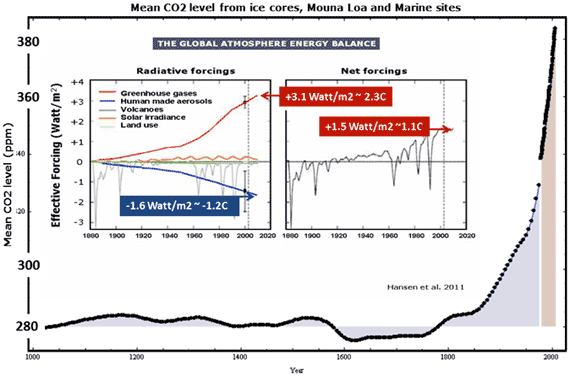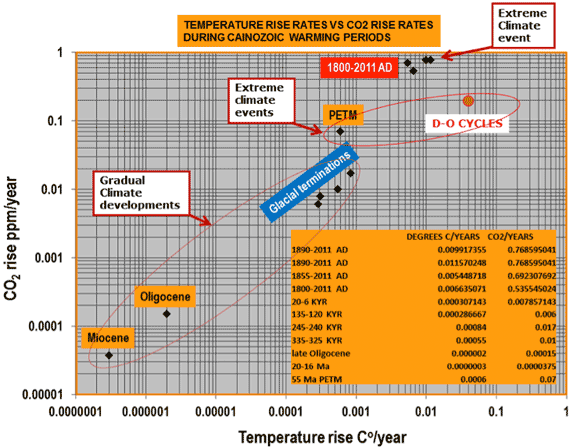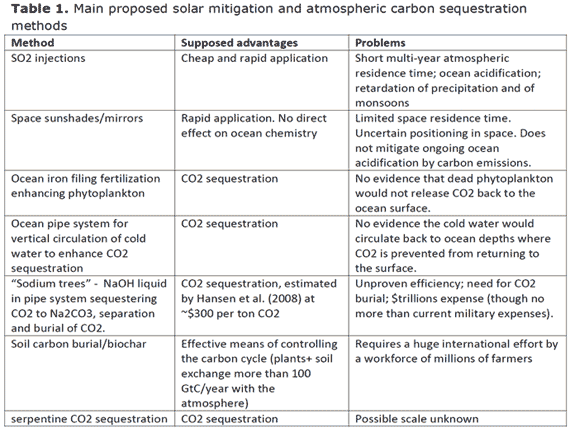No alternative to atmospheric CO2 draw-down
Posted on 14 February 2013 by Andrew Glikson
This article suggests that the current atmospheric CO2 level is already triggering amplifying feedbacks from the Earth system and therefore, in themselves, efforts at reduction in atmospheric CO2-emission are no longer sufficient to prevent further global warming. For this reason, along with sharp reductions in carbon emissions, efforts need to be undertaken in an attempt to reduce atmospheric CO2 levels from their current level of near-400 ppm to well below 350 ppm. NASA-applied outer space-shade technology may buy time for such planetary defense effort.
The scale and rate of modern climate change have been greatly underestimated. The release to date of a total of over 560 billion ton of carbon through emissions from industrial and transport sources, land clearing and fires, has raised CO2 levels from about 280 parts per million (ppm) in pre-industrial periods to 397-400 ppm and near 470 ppm CO2-equivalent (a value which includes the CO2-equivalent effect of methane), reaching a current CO2 growth rate of about 2 ppm per year

Figure 1: Part A. Mean CO2 level from ice cores, Mouna Loa observatory and marine sites; Part B (inset). Climate forcing 1880 – 2003. Aerosol forcing includes all aerosol effects, including indirect effects on clouds and snow albedo. GHGs include ozone (O3) and stratospheric H2O, in addition to well-mixed greenhouse gases.

Figure 2: Relations between CO2 rise rates and mean global temperature rise rates during warming periods, including the Paleocene-Eocene Thermal Maximum, Oligocene, Miocene, glacial terminations, Dansgaard-Oeschger cycles and the post-1750 period.
These developments are shifting the Earth’s climate toward Pliocene-like (5.2 – 2.6 million years-ago; mean global temperatures of +2-3oC above pre-industrial temperatures) and possibly toward mid-Miocene-like (approximately 16 million years-ago; mean global temperatures +4oC above pre-industrial temperatures) conditions within a few centuries?a geological blink of an eye.
The current CO2 level generates amplifying feedbacks, including the reduced capacity of warming water to absorb CO2 from the atmosphere, CO2 released from fires, droughts, loss of vegetation cover, disintegration of methane released from bogs, permafrost and methane-bearing ice particles and methane-water molecules.
With CO2 atmospheric residence times in the order of thousands to tens of thousands years, protracted reduction in emissions, either flowing from human decision or due to reduced economic activity in an environmentally stressed world, may no longer be sufficient to arrest the feedbacks.
Four of the large mass extinction of species events in the history of Earth (end-Devonian, Permian-Triassic, end-Triassic, K-T boundary) have been associated with rapid perturbations of the carbon, oxygen and sulphur cycles, on which the biosphere depends, at rates to which species could not adapt.
Since the 18th century, and in particular since about 1975, the Earth system has been shifting away from Holocene (approximately 10,000 years to the pre-industrial time) conditions, which allowed agriculture, previously hindered by instabilities in the climate and by extreme weather events. The shift is most clearly manifested by the loss of polar ice. Sea level rises have been accelerating, with a total of more than 20 cm since 1880 and about 6 cm since 1990.
For temperature rise of 2.3oC, to which the climate is committed if sulphur aerosol emission discontinues (see Figure 1), sea levels would reach Pliocene-like levels of 25 meters plus or minus 12 meters, with lag effects due to ice sheet hysteresis (system inertia).
With global atmospheric CO2-equivalent (a value which includes the effect of methane) above 470 ppm, just under the upper stability limit of the Antarctic ice sheet, with current rate of CO2 emissions from fossil fuel combustion, cement production, land clearing and fires of ~9.7 billion ton of carbon in 2010, global civilization faces the following alternatives:
- With carbon reserves sufficient to raise atmospheric CO2 levels to above 1000 ppm, continuing business-as-usual emissions can only result in advanced melting of the polar ice sheets, a corresponding rise of sea levels on the scale of meters to tens of meters, on a time scale of decades to centuries, and high to extreme continental temperatures rendering agriculture and human habitat over large regions unlikely.
- With atmospheric CO2 at about 400 ppm, abrupt decrease in carbon emissions may no longer be sufficient to prevent current feedbacks (melting of ice, methane release from permafrost, fires). Attempts to stabilize the climate require global efforts at CO2 draw-down, using a range of methods, including global reforestation, extensive biochar application, chemical CO2 sequestration (using sodium hydroxide, serpentine and new innovations) as well as burial of CO2.
As indicated in Table 1, the use of short-term solar radiation shields such as sulphur aerosols cannot be regarded as more than a band aid, with severe deleterious consequences in terms of ocean acidification and retardation of the monsoon and of precipitation over large parts of the Earth.

By contrast, retardation of solar radiation through space sunshade technology may allow time for CO2 draw-down. Unlike sulphur dioxide injections this will not have ocean acidification effects – an effort requiring a planetary defense project by NASA.
Dissemination of ocean iron filings aimed at increasing fertilization by plankton and algal blooms, or temperature exchange through vertical ocean pipe systems, are unlikely to constitute effective means of transporting CO2 to relatively safe water depths.
By contrast to these methods, CO2 sequestration through fast track reforestation, soil carbon, biochar and possible chemical methods such as “sodium trees” and serpentine (combining Ca and Mg with CO2) may be effective, provided these are applied on a global scale
Such efforts will require an effective planetary defense effort on the scale currently expended on military spending (totaling more than $20 trillion since WWII).
It is likely that a species which decoded the basic laws of nature, split the atom, placed a man on the moon and ventured into outer space should also be able to develop the methodology for fast sequestration of atmospheric CO2. The alternative, in terms of global heating, sea level rise, extreme weather events, and the destruction of the world’s food sources is unthinkable.
Good planets are hard to come by.































 Arguments
Arguments






























MA Rodger @49, thankyou for pointing out my error. As it happens, I made it consistently, ie, at each point where I should have mentioned Pg C, I mentioned Pg CO2. Consequently the entire post is correct once the substitution for the correct figure is made.
I should note that figure of one trillion tonnes Carbon as the achievable lower limit of emissions comes from Allen et al 2009, and certain related papers. A count of the best estimate of emissions todate is kept at trillionthtonne.org. They indicate that at current emission rates, the trillionth tonne will be emitted in June, 2041. Just 28 years!
With regard to the fossil fuel reserve, 5,000 GtC is approximately the World Energy Council 2010 estimate of possible reserves, which with emissions todate comes to 3,575 GtC. Possible reserves include reserves which have not been proven, or are uneconomic with current technology and prices and which estimates of the likilihood of future recovery are uncertain. The International Energy Agency 2011 reports a Total Resource Base of fossil fuels which, together with emissions todate, represents cumulative emissions of 16,700 GtC. Not all of that will be recoverable under any circumstance, but it is likely that new discoveries, especially as that figure does not include oil sands, tar sands and shale oil. If we are determined to exploit every economic fossil fuel resource regardless of consequences, given a few centuries we will, I think, go well beyond the 5,000 GtC estimate used by Archer. (Figures and sources taken from my spread sheet.)
An additional note on reserves: the "possible reserves" include all proven reserves, all probable reserves (defined as reserves having a 50% chance of being commercially recovered with current technology and prices), and all possible reserves (defined as having a 10% chance of being recovered at current technology and prices). Obviously as technology improves and prices rise, recovery rates will go well above the 50 and 10% figures. Further, as noted by MA Rodger, these reserves do not include the vast majority of tar sands, oil sands and shale oils, and nor do they include unconventional gas (clathrates and gas recoverable only by fracking or underground gasification).
The total resource base estimate by the IEA includes all fossil fuels currently estimated to be in the ground, excluding the majority of unconventional oil resources (tar sands etc) and clathrates. Gas recoverable only by fracking and gas from underground gasification will be included as part of current gas and coal TRB respectively.
I suspect these distinctions are academic, in any event. Once we get up towards 3,500 GtC total emissions, Mean Global Surface Temperatures are likely to be 6 degrees above the pre-industrial average out to 10 thousand years from now (peaking somewhere between that and 10 C above the preindustrial). I do not expect the ability or will to keep on burning fossil fuels will long survive in that sort of climate.
My proposal “Emergency 20-year Drawdown of Excess CO2 via Push-Pull Ocean Pumps” is a geoengineering finalist in the Climate CoLab competition at MIT.